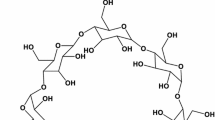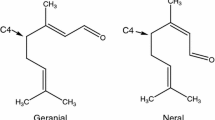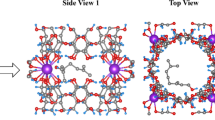Abstract
AHTN (7-Acetyl-1,1,3,4,4,6-hexamethyl-1,2,3,4-tetrahydronaphthalene), commercially known as fixolide or tonalide, is a synthetic fragrance widely used in replace of natural musk odor which is more expensive. It is a popular fragrance material added in the manufacturing of personal care and household products, such as perfumes, soaps, shampoos, detergents, and fabric softeners. AHTN is semivolatile and is degraded under light exposure and high temperature. This work focuses on the complexation of AHTN with cyclodextrins in the effort to stabilize the fragrance material. AHTN was complexed with β-cyclodextrin, methyl (MβCD), and hydroxypropyl (HPβCD) derivatives in the mole ratio 1:1, 1:2, and 1:3 guest:host, and the complexes formed by physical mixing, co-precipitation, kneading, and freeze-drying were analyzed by DSC and FTIR. Percent AHTN included in the complex was also determined by hexane extraction and GC analysis. It was found that no inclusion complex was formed in the physical mixture. When co-precipitation method was performed, only βCD could form inclusion complex with AHTN, while the other two derivatives could not. Using 1:2 AHTN:βCD, no free AHTN was left in the complex as evidenced by DSC and FTIR spectrum. In kneading and freeze-drying methods, complexes could be formed with all CDs tested. However, co-precipitation method with 1:2 AHTN:βCD and kneading method with 1:2 AHTN:MβCD provided the highest complex yield with highest amount of AHTN included in the complex. AHTN in the complex form was more stable against high temperature and UV exposure than its free form.





Similar content being viewed by others
References
Bender, H.: Production, characterization and application of cyclodextrins. Adv. Biotech. Proc. 6, 31–71 (1986)
Szejtli, J: Cyclodextrin Technology, Chapters 1 and 5. Kluwer Academic Publishers (1988)
Szente, L., Szejtli, J.: Highly soluble cyclodextrin derivatives: chemistry, properties, and trends in development. Adv. Drug Del. Rev. 36, 17–28 (1999)
Peck, A.M, Hornbuckle, K.C.: Synthetic musk fragrances in Lake Michigan. Environ. Sci. Technol. 38, 367–372 (2004)
Rimkus, G.G.: Polycyclic musk fragrances in the aquatic environment. Toxicol. Lett. 111, 37–56 (1999)
Giordano, F., Novak, C., Moyano, J.R.: Thermal analysis of cyclodextrins and their inclusion compounds. Thermochim. Acta. 380, 123–151 (2001)
Mura, P., Faucci, M.T., Parrini, P.L., Furlanetto, S., Pinzauti, S.: Influence of the preparation method on the physicochemical properties of ketoprofen–cyclodextrin binary systems. Int. J. Pharm. 179, 117–128 (1998)
Hara, K., Mikuni, K., Hara, K., Hashimoto, H.: Effects of cyclodextrins on deodoration of “Aging Odor”. J. Inclusion Phenom. Macro. Chem. 44, 241–245 (2002)
Reineccius, T.A, Reineccius, G.A., Peppard, T.L.: Utilization of β-cyclodextrin for improved flavor retention in thermally processed foods. J. Food Sci. 69(1), 58–62 (2004)
Saikosin, R., Tipaporn, L., Pongsawasdi, P.: Formation of inclusion complexes between cyclodextrins and carbaryl and characterization of the complexes. J. Inclusion Phenom. Macro. Chem. 44, 191–196 (2002)
Acknowledgements
The financial support from Rachadapiseksompote Fund, 90 years CU Fellowship and the support to Starch and Cyclodextrin Research Unit of Chulalongkorn University is appreciated.
Author information
Authors and Affiliations
Corresponding author
Rights and permissions
About this article
Cite this article
Chittiteeranon, P., Soontaros, S. & Pongsawasdi, P. Preparation and characterization of inclusion complexes containing fixolide, a synthetic musk fragrance and cyclodextrins. J Incl Phenom Macrocycl Chem 57, 69–73 (2007). https://doi.org/10.1007/s10847-006-9219-6
Received:
Revised:
Accepted:
Published:
Issue Date:
DOI: https://doi.org/10.1007/s10847-006-9219-6




